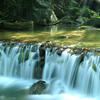The facts about water resources on Earth are stark. Today, 785 million people don’t have access to clean water. Water is under extreme threat from climate change — severe droughts and flooding threaten people’s access to clean water. More than 40 percent of the global population will live in water scarce areas by 2050. It is up to us to protect and maintain our precious water resources for today and tomorrow!
Learn About Ephemeral Pools With the Temple Ambler Field Station
In this video, Mary Cortese, Research Assistant with the Temple Ambler Field Station, explores ephemeral, or vernal pools and their place in the ecosystem of the Temple Forest Observatory.
“Did you know that only three percent of the world’s water is fresh water? Fresh water can be found in a lot of forms. It can be found in lakes, in streams and in rivers. It can also be in a vernal pool, also known as a vernal pond of ephemeral pool.
A vernal, or ephemeral, pool is a seasonal body of water similar to a small pond that fills with rain every season. In the late fall or in summer, it could still be dry, but in the spring, it will fill due to snow melt and rainwater. We didn’t have many ephemeral pools at the Temple Ambler Field Station until September 2021, when the campus was hit by a tornado.
The tornado came through and create the perfect space for vernal pools to form when it knocked over many of our old growth trees in the Temple Forest Observatory. When the trees fell over, then created pits, which fill with water when it rains. They create the perfect ecosystem for mammals to drink out of, like deer or raccoons, or coyotes. They also create the perfect breeding ground for amphibians such as salamanders and frogs.
Each pool can be different depending on the soil that surround it, the nutrients that get into it, the depth and even how much sunlight it gets. I’ve been spending the last year with the Field Station taking samples of these pools. From these samples, we can figure out what kind of microorganisms are living in them and how those microbiological communities have been changing over time. These pools might seem small, but they play a really important role in our ecosystem.”
Researching Water: Marine Biology
How do we learn about the Earth’s water bodies? How do we discover new species living in our oceans or new threats to our clean water systems? Whether it’s on a beach, in a salt marsh, investigating a mud flat or far out to seas, one of the professions working on the front lines is marine biology.
Join Dr. Rob Jennings, Assistant Professor of Instruction in Biology and Laboratory Manager for Teaching Labs in the Biology Department at Temple University, as he shares insights into what it is like to be a marine biologist for 25 years.
Researching Water: Marine Biology — Out to Sea
In this second part of his exploration of the field of marine biology, Dr. Rob Jennings, Assistant Professor of Instruction in Biology and Laboratory Manager for Teaching Labs in the Biology Department at Temple University, shares what it’s like to head out to sea on a variety of research vessels. Marine biologists may stay on these incredible vessels for six weeks to two months in locations all over the Earth while they conduct research vital to the health of the world’s waters.
Stormwater Management Gardens in the Ambler Arboretum
In this video, Ambler Arboretum Director Kathy Salisbury takes you on a rainy tour of the gardens that are not only beautiful and habitats but also help to capture stormwater before it runs into nearby creeks and streams. These stormwater management gardens both began as concepts developed by Temple University Landscape Architecture students for Philadelphia Flower Show exhibits. Now they are permanent gardens in the Arboretum. The gardens collect stormwater from around campus, slowing it down and storing it in basins until it drains into the soils below the garden, recharging the groundwater. The gardens slow water down, keep it on campus, prevent the water from picking up pollutants and help to clean the water. They also help to mitigate some of the flooding we all experience by keeping excess water out of small creeks and streams. (Please Note: Structures within the Sustainable Wetland Garden received extensive damage during the EF2 tornado that struck Temple University Ambler on September 1, 2021. This video was taken prior to those events.)
Stream Bank Erosion
Stream bank erosion happens when high water has cut into stream bank sediments, eroding them. Lack of vegetation enhances erosion and the steep slopes just keep getting steeper. In this presentation created by Dr. Laura Toran, the Weeks Chair in Environmental Geology and Professor in the Department of Earth and Environmental Science in the College of Science and Technology, learn about erosion, urban runoff, why erosion is a problem and how researchers are monitoring stream bank erosion and controlling stormwater.
DRBC Science Programs: Assessing the Delaware River
EarthFest Presents World Water Day event partner the Delware River Basin Commission Executive Director Steve Tambini discusses how DRBC uses sound science to ensure that the water resources of the Delaware River Basin are properly managed and protected. The members of this regional body - the Delaware River Basin Commission (DRBC) - include the four basin state governors and the Division Engineer, North Atlantic Division, U.S. Army Corps of Engineers, who serves as the federal representative. Commission programs include water quality protection, water supply allocation, regulatory review (permitting), water conservation initiatives, watershed planning, drought management, flood loss reduction, and recreation.
In the Field: Sample Collection
Because you can't manage what you don't measure, Delware River Basin Commission staff are active in the field throughout the year monitoring the health of the Delaware River and collecting data to support various DRBC water quality monitoring programs.
A Snapshot of the Delware River
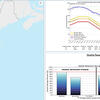
The Delaware River Basin Commission provides an interactive "snapshot" for flow and drought managment in the Delaware River Basin. Zoom in and out of graphs to explore your region, expand graphs to learn a variety of basin information. This information is updated once daily. Give it a try here.
Farming for the Future
The U.S. Environmental Protection Agency works with local partners to protect drinking water sources in Berks County, Pennsylvania, by helping local farms to install conservation practices which encourage a vibrant and healthy agricultural economy. Visit here for more information about Conservation Efforts on Farms. Video used with permission from EarthFest Presents: Celebrating the Earth partner U.S. EPA Region III.
Water and Climate Change
The climate is changing and will continue to change, affecting societies mainly through water. The 2020 United Nations World Water Development Report focused on the challenges, opportunities and potential responses to climate change, in terms of adaptation, mitigation and improved resilience that can be addressed through improving water management. Combining climate change adaptation and mitigation, through water, is a win-win proposal, improving the provision of water supply and sanitation services and combating both the causes and impacts of climate change, including disaster risk reduction.
International Decade for Action on Water for Sustainable Development, 2018-2028 - Midterm Comprehensive Review

Access to water and sanitation is a precondition to life and a declared human right. Water is vitally important to sustainable development - from health and nutrition, to gender equity and economics. Over the years, our water-related challenges will become more urgent. In order to accelerate efforts towards meeting water-related challenges, the United Nations General Assembly declared 2018-2028 as the International Decade for Action "Water for Sustainable Development." The resolution A/RES/73/226 calls for a Conference on the Midterm Comprehensive Review of the Implementation of the Objectives of the International Decade for Action to be convened in New York from 22 to 24 March 2023.
Water Changes Everything
Almost one billion people live without clean drinking water. We call this the water crisis. It's a crisis because it only starts with water, but water affects everything in life. Health. Education. Food security. And the lives of women and children, especially. We can end the water crisis in our lifetime. But first we have to let everyone know it's happening. Learn how water changes everything in this video by charity: water.
Stormwater is Everyone's Responsibility
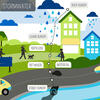
Did you know that the stormwater drains and inlets within your neighborhood have an important impact on the water quality of our streams? Why? Because storm drains flow directly to nearby rivers and streams, not to wastewater treatment plants. Your street is really like waterfront property and everything that rain washes off of your roof, yard, and driveway goes to the nearby water used for swimming, boating, and maybe even drinking. Anything dumped into these drains goes directly into a local stream. Everyone can help. Homeowners, business owners, developers, and other citizens should never dump anything into storm drains so we can protect our water from storm water pollution that may close beaches, cause unsightly weed and algae growth, and even kill fish! Learn more from Celebrating the Earth partner Upper Dublin Township.
Our Environment Begins in Your Yard

What you do in and with your yard can end up outside your yard, in your neighbor’s yard, in the storm drain or stream, and eventually in the ocean. If you multiply what you do in your yard by the number of people on your street, in your town, or in your state, your yard starts to look like everybody’s business. The environment really does begin with your yard! Upper Dublin Township provides a treasure trove of information on learning erosion and sediment control, your soil, controlling storm water, caring for your lawn, helping wildlife and much more!
Reduce Runoff: Slow It Down, Spread It Out, Soak It In
Green techniques are being used in urban areas to reduce the effects of stormwater runoff on the quality of downstream receiving waters. The goal, according to this video from the U.S. Environmental Protection Agency, is to mimic the natural way water moved before development, using design techniques to infiltrate, evaporate, and reuse runoff close to its source. Video used with permission from EarthFest Presents: Celebrating the Earth partner U.S. EPA Region III.
Rain Gardens: Saving Steams One Yard at a Time
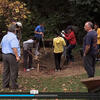
Watch the full rainwater garden video here!
Do you like gardening? Do you love seeing birds and butterflies at flight in your yard? Creating a rain garden offers therapuetic exercise, attracts wildlife, and helps keep stormwater runoff from overburdening sewer systems - or entering local streams. A rain garden is an attractive landscaped area planted with wildflowers and other vegetation (preferably native to the area) that has been designed to collect water that runs off a roof, driveway, or other parts of a property, including area lawns. Rain gardens are intended to fill with water during storms and slowly filter the water into the ground. Rain gardens are an economical way of dealing with rainfall the way nature intended by infiltrating, slowing down, and reducing the volume of runoff that enters a stormwater system. During heavy rains, they can prevent storm sewer overflows that can end up in our rivers and streams. This video from StormwaterPA features rain gardens in Ambler Borough, Pennsylvania, which is located in the Wissahickon Watershed.
Learn About Rain Barrels
In this video from the Pennsylvania Horticultural Society, explore how a rain barrel and stormwater management can help your garden and the environment with Rosemary Howard, PHS Residential Stormwater Assistant Program Manager.
Yes, We Can Save the World's Coral Reefs
Coral reefs support the livelihoods and food security of people throughout the tropics. Yet many scientists are pessimistic about their future. The good news is that reefs do have a future - if we actually try much harder to save them. In this Tedx Talk, Professor Terry Hughes, Director of the Australian Research Council (ARC) Centre of Excellence for Coral Reef Studies, talks about his research, which focuses on the linkages between the ecology of reefs and their importance for societies and economies.
What Are Microplastics?
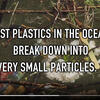
Watch the full video on Microplastics here
Plastic is everywhere. A lot of it ends up in the ocean according to the National Ocean Service, part of the National Oceanic and Atmospheric Administration (NOAA). Most plastics in the ocean break up into very small particles. These small plastic bits are called "microplastics." Other plastics are intentionally designed to be small. They're called microbeads and are used in many health and beauty products. They pass unchanged through waterways into the ocean. Aquatic life and birds can mistake microplastics for food. Research is being conducted, but there's still much we don't know. In 2015, the U.S. banned the use of microbeads. But microplastics are still a huge problem. You can help keep plastic out of the ocean. Remember: Reduce. Reuse. Recycle.

